Evaluating light curing units for three bulk-cured composites
How different light curing units influence the polymerization of bulk composite materials.
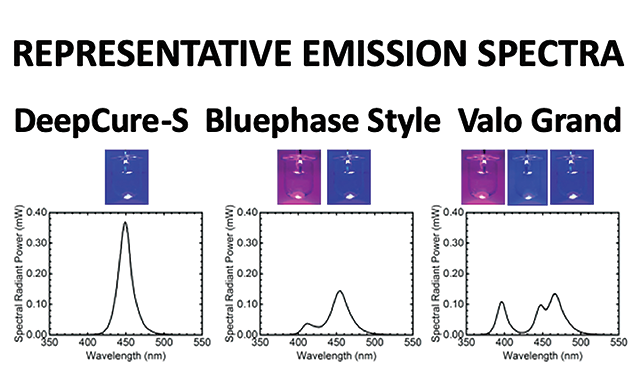
In 2018, I began pursuing research regarding the influence of different light curing units on the polymerization of bulk composite materials from three manufacturers. The focus of the testing was to analyze both the curing lights and bulk-cured composites.
The study was designed to determine if you need a broad-spectrum Polywave curing light to cure a composite, or can a single-peak light-emitting diode (LED) curing light achieve the same result?; and will bottom-to-top hardness ratios vary across the bulk fill formulations?
Three light curing units (LCU) and three bulk fill resin-based composites were evaluated, each tested against the other according to the manufacturer’s instructions.
Materials overview
The materials below were selected with the objective of evaluating wide specimens of three bulk fill composites that were cured using different curing lights.
Read more: Light curing: What you can't afford to be in the dark about
The three light-emitting diode LCUs in this study were:
- 3M™ Elipar™ DeepCure-S
- Ultradent VALO™ Grand
- Ivoclar Vivadent Bluephase® Style
For more context regarding the LCUs, the DeepCure-S is a single-peak LED light. The VALO Grand is a multiple-peak emission LED light, while the Bluephase Style is a dual-peak emission Polywave LED light.
The three bulk fill resin composites used in the study are as follows:
- 3M™ Filtek™ One Bulk Fill Restorative in shade A2
- Ivoclar Vivadent Tetric EvoCeram® Bulk Fill in shade IVA
- Kerr Dental SonicFill™ 2 in shade A2
Tetric EvoCeram Bulk Fill was chosen because it contains the alternative photoinitiator, Ivocerin, in addition to Camphorquinone, and it’s made by the manufacturer of the Polywave curing light. These materials were measured against the same performance standards. The LCUs were evaluated for power, irradiance, tip diameter and light homogeneity. The bulk fill resin composites were tested for hardness at the bottom and at the top.
Light curing units
The LCUs were tested on their light output, irradiance, the presence of hotspots and beam uniformity. When measured with digital calipers, the active tip diameter of the VALO Grand from where light was emitted was 11.7 mm, the DeepCure-S 9.0 mm and the Bluephase Style 8.7 mm. The DeepCure-S is a single-peak LED curing light delivering a peak irradiance at 449 nm. The VALO Grand is a multiple-peak LED curing light delivering peak outputs at 396, 448 and 466 nm. The Bluephase Style is a dual-peak Polywave LED curing light delivering peak outputs at 411 and 458 nm.
Five specimens of each composite were light-cured with each LCU in metal molds that were 4 mm deep and 12 mm in diameter. Using a custom made aligning device, the light curing units were positioned with the center of their light tip over the center of the molds and 2 mm away from the surface. This represented the average distance between a cusp tip and the occlusal fossa and, thus, the closest distance the light tip could be clinically.
After light curing and 24 hours of storage at 37°C in the dark, a Mitutoyo microhardness tester was used to measure the Knoop hardness at the top and bottom of the composites. The bottom-to-top hardness ratio was also calculated.
The total power output from the curing lights was measured five times through a fixed 12.5 mm aperture into a previously-calibrated integrating sphere (Labsphere). This aperture allowed all the light from each of the lights to be captured. The Bluephase Style delivered a similar power to the DeepCure-S, but the VALO Grand delivered the greatest total power (Fig. 1).

Fig. 1
The three lights emitted different spectra: the DeepCure-S was a single-peak LED LCU, the Bluephase Style was a dual-peak LED light and the VALO Grand had three emission peaks (Fig. 2).

Fig. 2
The irradiance at the light tip is calculated by dividing power by the active tip area of the light. Although the VALO Grand was a more powerful light, because the active tip area of the VALO was greater, the calculated irradiance values were virtually the same from all three lights (Fig. 2). It should be noted the DeepCure-S is a powerful light at 785 mW, whereas many LCUs deliver 500 mW or less, but they boost their irradiance. The DeepCure-S delivers a lot of power in the 450 nm region. This is one feature that makes the DeepCure-S a very effective LCU.
Beam uniformity measures how uniform the light output is from the curing light, as shown in Figure 3. Ideally, all regions of the light tip would emit the same irradiance and wavelengths of light, but this didn’t occur for the Bluephase Style where the wavelength depended on the location of the light tip (circles indicate measurement locations on Figure 3).
Continue reading on page two...
LCU testing summary
All three LCUs showed steady light outputs and overall acceptable performance. The VALO Grand was the most powerful (Fig. 3) and had the widest tip. Of the three lights tested, the Bluephase Style didn’t exhibit the same beam uniformity as the VALO Grand or the DeepCure-S (Fig. 3). All three lights delivered similar irradiance values between 1203 and 1266 mW/cm2.
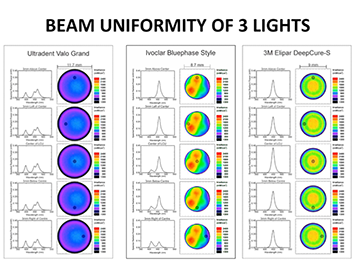
Fig. 3
Bulk fill composite testing
To test how well the bulk fill resin composites were cured by each curing light, we used metal molds that were 4 mm deep and 12 mm in diameter. Typically, depth cure testing is performed using metal molds with a diameter of 4 mm, rather than 12 mm. However, we chose a mold size that was slightly larger than the average molar tooth that’s 11 mm from the mesial to the distal. This wide mold allowed an accurate assessment of how the lights would cure the material in a large mesial occlusal distal (MOD) restoration.
Material transparency was an important aspect examined in the bulk fills. In Figure 4, you can see transparency varied between the composites. SonicFill was more opaque and transmitted the least amount of light. The light transmission didn’t change significantly during curing. The other two materials, Filtek One and Tetric EvoCeram, became more transparent as they cured and allowed more light to reach the bottom of the composite (Fig. 4).
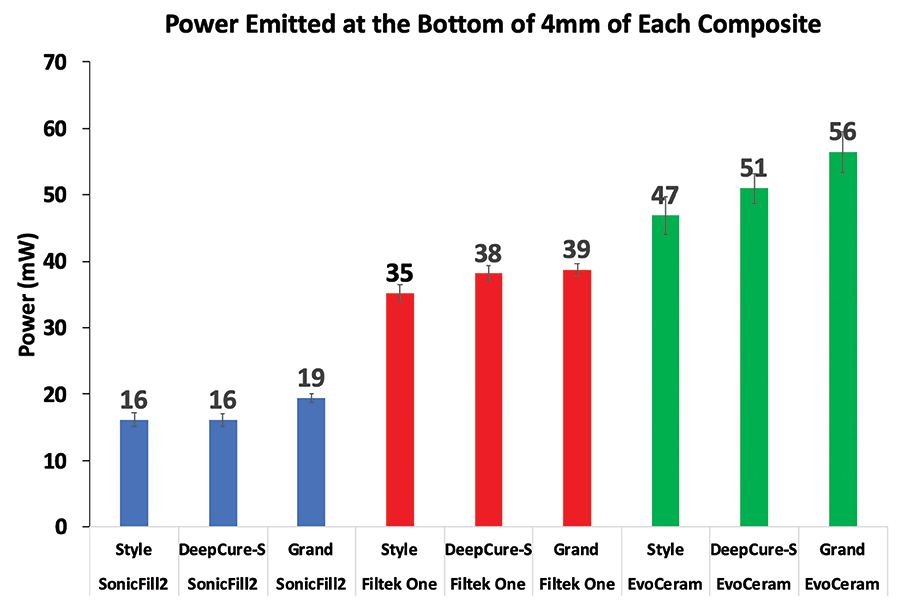
FIg. 4
The Bluephase Style, the Polywave light, transmitted very little violet light through to the bottom of the composites. Almost none of the violet light reached to the bottom of 4 mm of Filtek One and SonicFill composite. Using the VALO Grand, the SonicFill again allowed the least amount of light to reach the bottom of 4 mm of composite, as it did consistently with all three LCUs.
The hardness results revealed that Tetric EvoCeram had the lowest hardness at the top surface (Fig. 5). There was no difference between the Bluephase Style and the DeepCure-S curing lights. Overall, the VALO Grand produced a wider region of hard composite, and this was attributed to the wider tip diameter of the VALO Grand at 11.7 mm compared to the 9 mm diameter of the DeepCure-S and 8.7 mm of the Bluephase Style. Of note, 3M Filtek One achieved the highest ratio of bottom-to-top hardness across all three curing lights, indicating that no matter which light was used, all would produce a high hardness ratio.
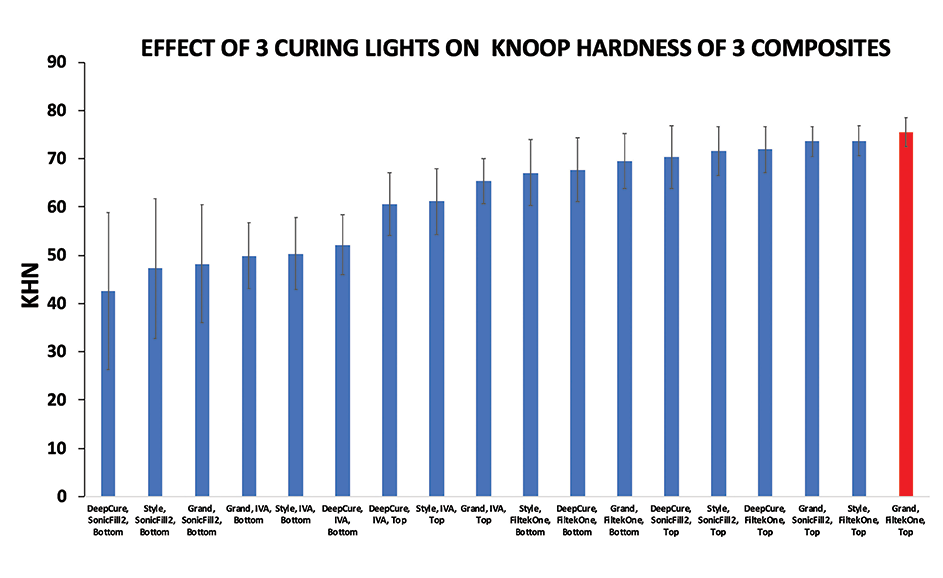
Fig. 5
Continue reading on page three...
Bulk fill composite testing summary
With all three LCUs, SonicFill performed the worst compared to the other bulk fill resin composites that were tested. 3M Filtek One had the best bottom-to-top hardness ratios when paired with any of the three curing lights (Fig. 6).
A key factor of this testing was following the manufacturer’s instructions for curing. 3M Filtek One Bulk Fill was light-cured for 20 seconds, whereas the SonicFill and Tetric EvoCeram were cured for 10 seconds. Thus, the 3M Filtek One Bulk Fill was light cured for twice as long as the other two composites.
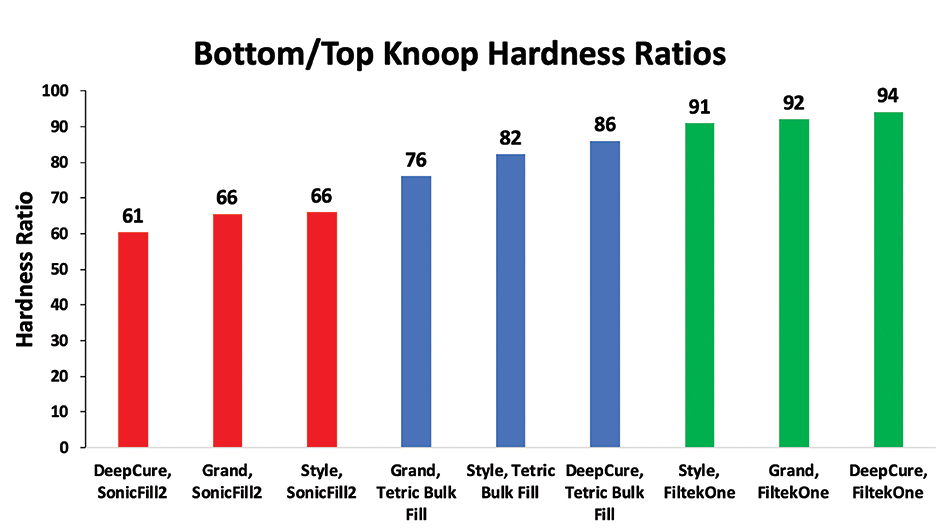
Fig. 6
Bottom-to-top ratio
When the bottom-to-top hardness ratios were examined, it was found that 3M Filtek One, when light-cured for 20 seconds, achieved better than a 90 percent ratio with all three curing lights. SonicFill 2 had the lowest hardness ratios of 61 to 66 percent (Fig. 6).
Clinical takeaways
In general, all three curing lights showed comparable performance when light curing the three composites tested.
When used according to the manufacturer’s instructions, 3M Filtek One Bulk Fill outperformed the other two composites that were only light-cured for 10 seconds. 3M Filtek One Bulk Fill Restorative cured the hardest to a 4 mm depth. When light-cured for 20 seconds, Filtek One achieved better than a 90 percent ratio with all three curing lights. Conversely, when cured for 10 seconds, SonicFill’s opacity made it hard for light to reach through to the bottom of 4 mm of composite. SonicFill 2 also had the lowest bottom-to-top hardness ratios of 61 to 66 percent, but it was only light-cured for 10 seconds.
An important takeaway is some manufacturer’s instructions recommend longer curing times than others. Regarding curing lights, you don’t have to use a Polywave curing light to cure Ivoclar Vivadent’s bulk fill composite. The higher power from the 3M Elipar DeepCure-S was able to cure Tetric EvoCeram bulk fill composite adequately both at the top and down to 4 mm where it produced an 86 percent bottom-to-top hardness ratio.
If you use a Polywave curing light, don’t expect there to be any violet light at the bottom at 4 mm. This is especially important if you’re trying to cure both the composite and bonding agent simultaneously. Thus, a bonding agent that requires violet light may not bond as well, and the bonding agent should be cured first.
Overall, the VALO Grand produced slightly harder composites at the top and bottom due to its increased power output, but the clinician must remember that all this extra power means more energy is being delivered to the tooth and restoration. This may cause undesirable temperature increases in the pulp or soft tissues. The difference in hardness was also small and probably not clinically relevant.

Product Bites – November 10, 2023
November 10th 2023The weekly new products podcast from Dental Products Report is back. With a quick look at all of the newest dental product launches, Product Bites makes sure you don't miss the next innovation for your practice. This week's Product Bites podcast features new launches from Amann Girrbach, DMG, Pac-Dent, and ASI Dental Specialties. [4 Minutes]